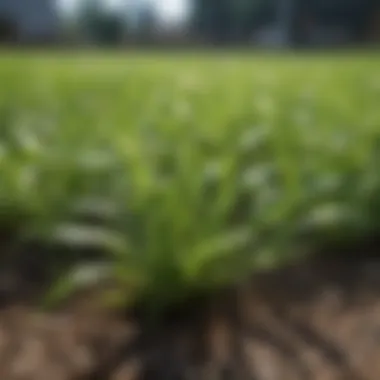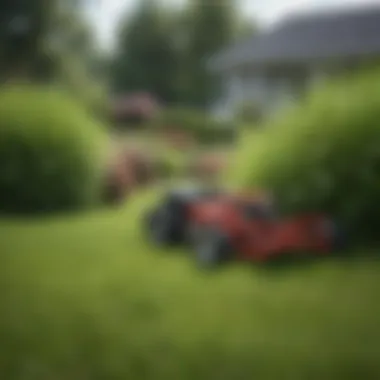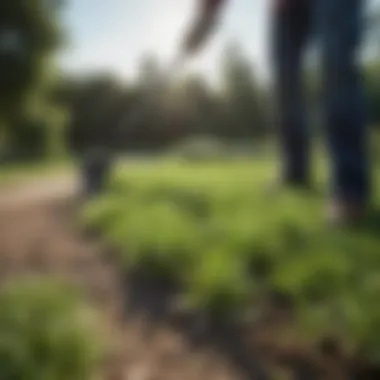Effective Methods to Get Rid of Crabgrass


Intro
Crabgrass is more than just an unsightly weed; it represents a significant challenge for many homeowners devoted to achieving a well-maintained lawn. This proliferative grass not only disrupts the aesthetic of the landscape but also competes fiercely for resources, hindering the growth of desired grass species. Understanding the biological factors of crabgrass can greatly enhance management strategies.
In this article, we will delve into effective methods for controlling and eradicating crabgrass from your lawn. We will examine its life cycle, discuss preventive techniques, and evaluate both manual and chemical removal methods. Each approach will be scrutinized for effectiveness as well as its environmental impact, providing homeowners the information needed to make informed decisions about their lawn care practices.
By synthesizing the insights presented throughout the article, readers will be equipped with actionable steps to not only restore their lawns but also to prevent future infestations of crabgrass.
Understanding Crabgrass
Crabgrass is a common weed that presents a significant obstacle for homeowners aiming to maintain a well-kept lawn. Understanding its characteristics is essential for effectively managing its growth. By delving into the biology and behavior of crabgrass, one can grasp why it thrives in certain environments and how to combat its spread.
Crabgrass Characteristics
Growth Habit
Crabgrass exhibits a sprawling growth habit. This means it grows low to the ground and spreads rapidly, often creating dense mats. This habit allows it to cover bare spots quickly, outcompeting desirable grass species for nutrients and sunlight. The sprawling nature of crabgrass can be troubling as it fills spaces left by healthier plants, effectively choking them.
Another notable aspect of its growth is its ability to root from nodes along its stems. This trait enables crabgrass to anchor itself firmly in the soil, making it resilient against attempts at removal. Therefore, understanding its growth habit helps homeowners identify vulnerable areas in their lawn, where proactive measures can be taken.
Life Cycle
Crabgrass is an annual plant, meaning it completes its life cycle within one growing season. It germinates in the spring when temperatures rise, typically around 55°F (13°C). Once established, it grows vigorously during the summer months. The primary characteristic of its life cycle is that it produces an extensive number of seeds, which can remain dormant in the soil for years.
This capability to produce a high seed count is significant, as it leads to rapid reinfestation if not managed effectively. Understanding the life cycle is crucial because it highlights the importance of early intervention, particularly with pre-emergent herbicides, which target seeds before they sprout.
Identification
Identifying crabgrass is vital for effective management. The plant has broad, flat leaves that grow in a rosette formation close to the ground. Mature crabgrass can reach a height of 12 inches, and its stems often turn purple as it matures. One of the most distinctive features is its tendency to form a loose, spreading pattern in areas with poor grass coverage.
Correct identification helps homeowners differentiate crabgrass from desirable grass species and other weeds. This knowledge enables targeted removal strategies. Relying on visual cues and learning about its growth pattern forms the foundation for an effective crabgrass management plan.
Why Crabgrass Thrives
Environmental Preferences
Crabgrass thrives in environments that offer ample sunlight and poor soil conditions. It prefers areas that are dry and compacted, making it a common sight in lawns that are either overwatered or undernourished. This characteristic is important because it informs homeowners about ideal conditions for its growth, as well as areas where they should focus their pulling or treatment efforts.
Understanding these environmental preferences can guide homeowners in adjusting their lawn care practices, so the conditions become less favorable for crabgrass to thrive, which can lead to more effective management over time.
Common Conditions for Growth
Crabgrass tends to flourish in cooler soil temperatures during the early spring and in warmer climates overall. It commonly appears where there is limited competition from other plants due to stress factors. For example, over-fertilization, inadequate mowing, or poor irrigation can create open spaces ideal for crabgrass infestation.
Awareness of these conditions allows homeowners to customize their lawn maintenance strategies effectively. By improving overall lawn health and vigor, they can reduce the likelihood of crabgrass establishment on their property. This knowledge empowers readers to implement preventative measures based on their specific lawn conditions, enhancing the long-term success of their lawn management efforts.
Preventive Strategies
The significance of preventive strategies in crabgrass management cannot be overstated. Effective prevention lays the groundwork for maintaining a healthy lawn and minimizes the chance of crabgrass taking root. Implementing these practices can save homeowners time and effort in the long run while promoting a more resilient lawn that effectively stands against invasions of weeds.
Lawn Maintenance Practices
Mowing Techniques
Mowing is a critical element of lawn care that has direct implications for crabgrass prevention. Maintaining the grass at the right height can help create a denser lawn, which competes more vigorously against crabgrass. Typically, mowing at a height of at least three inches is recommended. This height encourages a stronger root system and reduces the amount of sunlight that reaches crabgrass seeds. Additionally, regular mowing prevents the grass from going to seed, which serves to further suppress crabgrass growth. However, if done incorrectly, frequent mowing can stress the lawn, resulting in weaker grass and more gaps for weeds to fill.
Watering Schedule
Watering plays an equally vital role in lawn health. Developing a consistent watering schedule assists in promoting deep root growth while minimizing evaporation. Deep and infrequent watering, around one inch per week, is preferable as it encourages roots to grow down into the soil as opposed to staying near the surface. This method makes it harder for crabgrass seeds to take hold, as surface moisture favors their germination. However, overwatering can lead to shallow roots and confusion over water needs, ultimately resulting in an unhealthy lawn.


Nutrient Management
Nutrient management is essential for reinforcing a lawn's defense against crabgrass. Applying fertilizers correctly ensures that grass has sufficient nutrients to thrive. A nitrogen-rich fertilizer is often beneficial, but timing is key. Early spring applications can enhance grass growth before crabgrass begins to emerge. A soil test can identify specific nutrient deficiencies, helping guide fertilizer choices. However, excessive fertilization can lead to thatch buildup, which may create favorable conditions for weeds like crabgrass.
Choosing the Right Grass Seed
Grass Varieties
Selecting the right grass variety is a cornerstone of prevention. By opting for species that are well-suited to the local climate, homeowners can create a lawn that is more resistant to crabgrass. For instance, tall fescue is a drought-resistant option that establishes a strong root system, reducing the likelihood of crabgrass proliferation. Adaptability to local soil types and sunlight conditions further enhances lawn success. On the downside, some varieties may be more susceptible to disease or pests, necessitating careful consideration during selection.
Resilience Factors
Understanding resilience factors is key to developing a long-term strategy for crabgrass prevention. Factors such as drought tolerance and shade tolerance can dictate which grass varieties will thrive in specific environments. Choosing resilient grasses minimizes the need for excessive maintenance, allowing for a more sustainable lawn. While resilience contributes to a healthier lawn, it is crucial to balance with other lawn care practices to ensure comprehensive management of crabgrass.
Manual Removal Techniques
Manual removal techniques are critical in the battle against crabgrass. These methods allow homeowners to target the weed without the risk of chemical exposure, making them a preferred choice for those who prioritize organic lawn care. Hand-pulling and using weeding tools each have distinct advantages and can effectively control crabgrass populations when performed correctly.
Hand Pulling
Hand pulling is a simple yet effective way to eliminate crabgrass. This method involves manually removing the weed from the lawn, including the roots, which prevents regrowth. However, it requires some considerations to maximize its effectiveness.
Best Practices
When engaging in hand pulling, timing plays a pivotal role. It is most effective to pull crabgrass out when the soil is moist, allowing for easier removal of the entire root system.
- Technique: Work in a sectioned area of your lawn, ensuring you focus on patches with visible crabgrass.
- Key characteristic: Pulling is a completely non-chemical method, making it environmentally safe.
- Benefits: It encourages physical interaction with your lawn, enabling you to spot other weeds or issues.
However, the labor-intensive nature of this method and the potential for incomplete removal can be a drawback for homeowners with larger lawns.
Optimal Timing
The ideal time for hand pulling usually aligns with the early mornings or after rainfall. The moist conditions make it easier to extract the roots completely.
- Key characteristic: Early intervention is essential to prevent crabgrass from producing seeds.
- Benefits: Targeting young plants increases the likelihood of successful removal.
This technique requires patience, as it may need to be repeated multiple times throughout the growing season to be fully effective.
Using Weeding Tools
For homeowners who prefer less manual labor, using weeding tools can be an efficient strategy for crabgrass removal. Various tools are designed to assist in the extraction of weeds, providing leverage and ease of use.
Tools Overview
Weeding tools come in several types, from hand-held weeders to larger tools designed for extensive areas.
- Types of tools: Commonly used tools include dandelion pullers, hoe-type weeders, and garden forks.
- Key characteristic: Tools offer the mechanical advantage of removing deeper roots without excessive hand strain.
- Benefits: They expedite the removal process and can cover large areas in a shorter time.
While these tools can be effective, improper use may lead to surface damage to surrounding grass or may not remove the entire root, leading to potential regrowth.
Technique Tips
When using weeding tools, technique is crucial to ensure efficient weed control. Users should insert the tool close to the base of the crabgrass and apply an even pulling force.
- Key characteristic: Proper positioning reduces the risk of snapping the weed, making it less likely to regrow.
- Benefits: Using a weeder can save time and labor compared to hand pulling.
Homeowners should also clean tools regularly to avoid transferring diseases between plants. Each technique presents viable options for crabgrass management, allowing property owners to choose methods that align with their preferences and workloads.
Chemical Control Options


Chemical control options are a vital part of managing crabgrass effectively. These methods offer quick and convenient solutions that can address significant crabgrass infestations. By utilizing herbicides, homeowners can target crabgrass specifically and minimize its spread. Understanding how these chemicals work and how to apply them safely can greatly benefit anyone looking to maintain a healthy lawn.
Pre-emergent Herbicides
Pre-emergent herbicides play a crucial role in preventing crabgrass from germinating in the first place. These chemicals create a barrier in the soil that inhibits seed germination. Their effectiveness lies in proactive action, rather than reactive measures. Homeowners who apply these herbicides at the right time can significantly reduce the likelihood of crabgrass establishment in their lawns.
Mechanism of Action
The mechanism of action for pre-emergent herbicides involves the disruption of seed germination and root development. This prevents young crabgrass plants from establishing themselves. One key characteristic is the ability to disrupt cellular processes in germinating seeds, essentially “poisoning” them before they can grow. This unique feature makes pre-emergent herbicides a popular choice for lawn care, as they act before the problem appears.
However, there are disadvantages to consider. For example, if applied too late, they will not be effective against already existing crabgrass. Additionally, they may also affect desirable grass seeds if not used correctly.
Application Guidelines
Application guidelines are vital to ensure that pre-emergent herbicides work effectively. The timing of application is critical; it should typically be done in early spring before crabgrass seeds begin to germinate. A key aspect of these guidelines includes proper measurement for even coverage. This helps avoid under- or over-application, both of which can impact efficiency.
A unique feature of applying these herbicides is the requirement for watering it into the soil. This helps activate the chemical and create the protective barrier against seeds.
Nonetheless, improper timing or application can limit their effectiveness in crabgrass control.
Post-emergent Herbicides
Post-emergent herbicides are designed to combat crabgrass that is already established in the lawn. They offer a reactive approach, targeting the weed after it has germinated. Homeowners may prefer this method when a crabgrass invasion has already occurred, as it serves as a direct assault on visible weeds.
Effectiveness
The effectiveness of post-emergent herbicides varies depending on the specific product and the growth stage of the crabgrass. Some are designed to target young plants, while others may work on more mature crabgrass. A key strength of these herbicides is their ability to kill visible weeds quickly, leading to a more immediate improvement in lawn appearance. However, effectiveness can diminish if the crabgrass is allowed to flower or set seed, making timing crucial for optimal results.
Safety Considerations
Safety considerations cannot be overlooked when using post-emergent herbicides. It is essential to follow label instructions carefully to prevent harming desirable plants or causing environmental damage. A key characteristic of these herbicides is their potential volatility; improper application can lead to drift onto other plants.
Unique mitigating strategies include wearing protective gear during application and maintaining a safe distance from ornamental plants. Additionally, applying these products on calm days can help minimize drift. Thus, while they can be powerful allies in crabgrass control, they also require careful handling.
Integrated Pest Management for Crabgrass
Integrated Pest Management (IPM) provides a strategic framework for controlling crabgrass in a way that is both efficient and environmentally conscious. This approach is not just about erasing the weed; it emphasizes understanding the ecosystem of your lawn to address the root causes that allow crabgrass to thrive. By integrating multiple control tactics, IPM aims to suppress crabgrass populations effectively while minimizing harm to the surrounding environment. This is particularly important for homeowners who seek to maintain not only a healthy lawn but also a balanced ecosystem.
Combining Strategies
Holistic Approach
The holistic approach to managing crabgrass integrates various methods to create a comprehensive plan rather than relying on one technique alone. This strategy is beneficial because it acknowledges the complexity of ecosystems. Instead of applying a heavy chemical treatment uniformly, the holistic approach involves assessing the specific needs of your lawn and tailoring the interventions accordingly. A notable characteristic of this method is its focus on balancing natural and synthetic options.
The unique feature of the holistic approach lies in its ability to promote long-term solutions rather than quick fixes. For instance, instead of solely using herbicides, which may have immediate effects but are often followed by crabgrass resurgence, this method encourages practices such as proper mowing, aeration, and choosing resilient grass species. The advantages include reduced chemical use, improved soil health, and increased lawn resilience against future infestations. However, a disadvantage could be the longer time required to see results, as multiple strategies need consistent application.
Monitoring and Assessment
Monitoring and assessment are critical components of an effective IPM strategy, serving to inform and adjust methods based on observed changes within the lawn. This practice enhances the management efforts by providing concrete data on crabgrass presence and the effectiveness of applied control measures. A key characteristic of monitoring and assessment is the emphasis on regular observation, which allows homeowners to make timely adjustments to their management strategies.
The unique feature of this practice is the concept of adaptive management. This means that as you monitor the lawn for crabgrass, you can change your approach based on what is working or not. Advantages of consistent monitoring include the early detection of crabgrass outbreaks and the effectiveness of preventing larger infestations. However, it does require some commitment of time and effort, which might be seen as a disadvantage by those with limited availability.
"Effective crabgrass management relies heavily on the principles of Integrated Pest Management, emphasizing prevention and monitoring rather than just reaction."
In summary, Integrated Pest Management offers a nuanced and effective way to deal with crabgrass by combining various methods while prioritizing lawn health and environmental considerations.
Long-term Lawn Health
Long-term lawn health is crucial for creating an aesthetically pleasing yard and preventing the establishment of crabgrass and other weeds. Healthy lawns not only offer visual appeal but also enhance environmental benefits such as air quality and soil preservation. Focusing on lawn health can lead to a more resilient and sustainable landscape.


A well-maintained lawn does not just repel crabgrass; it can actively outcompete it for resources. By investing in proper lawn care practices, homeowners can build a foundation for a thriving yard.
Soil Health Maintenance
Testing Soil Quality
Testing soil quality is a fundamental part of maintaining a healthy lawn. This process helps to identify nutrient deficiencies, pH imbalances, and overall soil structure. Soil tests provide valuable data that can guide homeowners in making informed decisions regarding fertilizers and amendments. A key characteristic of soil testing is its ability to pinpoint the specific needs of the lawn, making it a beneficial choice for any care regimen.
One unique feature of soil quality testing is its adaptability; tests can reveal the need for organic matter enhancement or soil aeration, which directly impact crabgrass management. While it might require an initial investment, the long-term advantages include reduced fertilization frequency and improved lawn resilience against pests, weeds, and diseases.
Aeration Benefits
Aeration is another important aspect of soil health maintenance. This process involves perforating the soil with holes to allow air, water, and nutrients to penetrate deeply. The key benefit of aeration is that it alleviates soil compaction, promoting better root growth and more robust grass. It serves as a popular method for improving turf vigor.
A unique feature of aeration is that it also helps in populating beneficial microbes and earthworms in the soil. Both of these contribute to better nutrient cycling and a more balanced ecosystem. While some may find aeration time-consuming or labor-intensive, the long-term advantages heavily outweigh the short-term inconvenience, making it a sensible choice for lawn care.
Scheduled Lawn Care
Seasonal Practices
Seasonal practices are essential for keeping a lawn in top condition year-round. Understanding when to fertilize, mow, and water based on seasonal changes can significantly influence the health of grass and the prevention of crabgrass. A key characteristic of seasonal practices is their proactive approach, allowing for timely interventions that keep the lawn vibrant.
For instance, applying pre-emergent herbicides during early spring is a critical step to inhibit crabgrass growth. This method not only helps maintain lawn aesthetics but also reduces the need for more aggressive removal methods later. Although seasonal practices may require continued monitoring and adjustments, they ultimately create a maintained lawn that thrives over time.
Sustainability Considerations
Sustainability considerations are becoming increasingly important in lawn care. These practices focus on environmentally friendly methods that do not compromise the lawn's health while minimizing negative effects on the ecosystem. Homeowners are encouraged to think about aspects such as water conservation and organic lawn care products.
The key benefit of sustainability in lawn care is that it fosters long-term health without reliance on chemicals that can harm beneficial organisms in the soil. One unique feature of sustainable practices is their multi-faceted approach, integrating uses for organic matter, native grass varieties, and efficient irrigation methods. While transitioning to sustainable practices may involve a steep learning curve, the benefits include healthier ecosystems and lower long-term maintenance costs.
End and Best Practices
Understanding how to effectively eliminate crabgrass is crucial for homeowners aiming to maintain a beautiful and healthy lawn. This discussion serves as a comprehensive summary of the various approaches covered in this article, including preventive measures, manual removal techniques, and chemical treatments. Each method has its own set of advantages and limitations, and it is essential to choose the right combination based on your specific lawn conditions and preferences. The integration of these techniques not only aids in crabgrass control but also promotes long-term lawn health.
Implementing best practices in lawn care is equally important. Regular lawn maintenance including proper mowing and watering can significantly reduce the likelihood of crabgrass establishment. Additionally, understanding the life cycle and growth habits of crabgrass empowers homeowners to intervene at the most effective times.
By following these best practices:
- Regularly monitor your lawn for signs of crabgrass.
- Employ preventive herbicides as recommended during the pre-emergent phase.
- Utilize manual removal techniques in early growth stages.
- Choose grass varieties that compete effectively against crabgrass.
These steps can create a robust defense against infestation, ensuring your lawn remains vibrant and healthy. Adopting such practices can shift your lawn from a constant battle with weeds to a flourishing green space.
Recap of Approaches
The techniques discussed earlier present a well-rounded approach to crabgrass management. Here’s a condensed overview:
- Preventive Strategies
- Manual Removal Techniques
- Chemical Control Options
- Integrated Pest Management
- Focused on routine lawn care practices that reduce crabgrass growth.
- Choosing appropriate grass varieties promotes competition.
- Hand-pulling or using specific tools to physically eliminate crabgrass before it seeds.
- Timing of removal is critical to effectiveness.
- Utilizes both pre-emergent and post-emergent herbicides.
- Ensure adherence to safety guidelines when applying chemicals.
- Emphasizes a holistic approach, combining various methods for optimal results.
- Regular assessment of techniques allows for adaptive management.
These strategies together create a multifaceted defense, giving homeowners a strong framework to combat crabgrass effectively.
Future Prevention
Avoiding crabgrass infestation in the future requires a commitment to ongoing lawn care. Here are several key considerations:
- Soil Health: Regular testing and maintenance of soil quality can improve your lawn’s resilience against crabgrass. Healthier soils support robust grass growth, which naturally competes against weeds.
- Sustainable Practices: Implementing eco-friendly practices like composting and organic fertilization enriches the soil and reduces reliance on chemical inputs.
- Seasonal Planning: Create a seasonal lawn care schedule that addresses specific needs at different times of the year. This schedule could include appropriate timings for overseeding and fertilization.
- Education and Awareness: Stay informed about the latest in lawn care and turf management techniques. Researching community resources, like local gardening forums on Reddit or informative articles in Wikipedia, can enhance your knowledge base.
By prioritizing the health and management of your lawn, future crabgrass invasions can be minimized or entirely prevented. This proactive approach makes all the difference in sustaining a lush and beautiful lawn.















